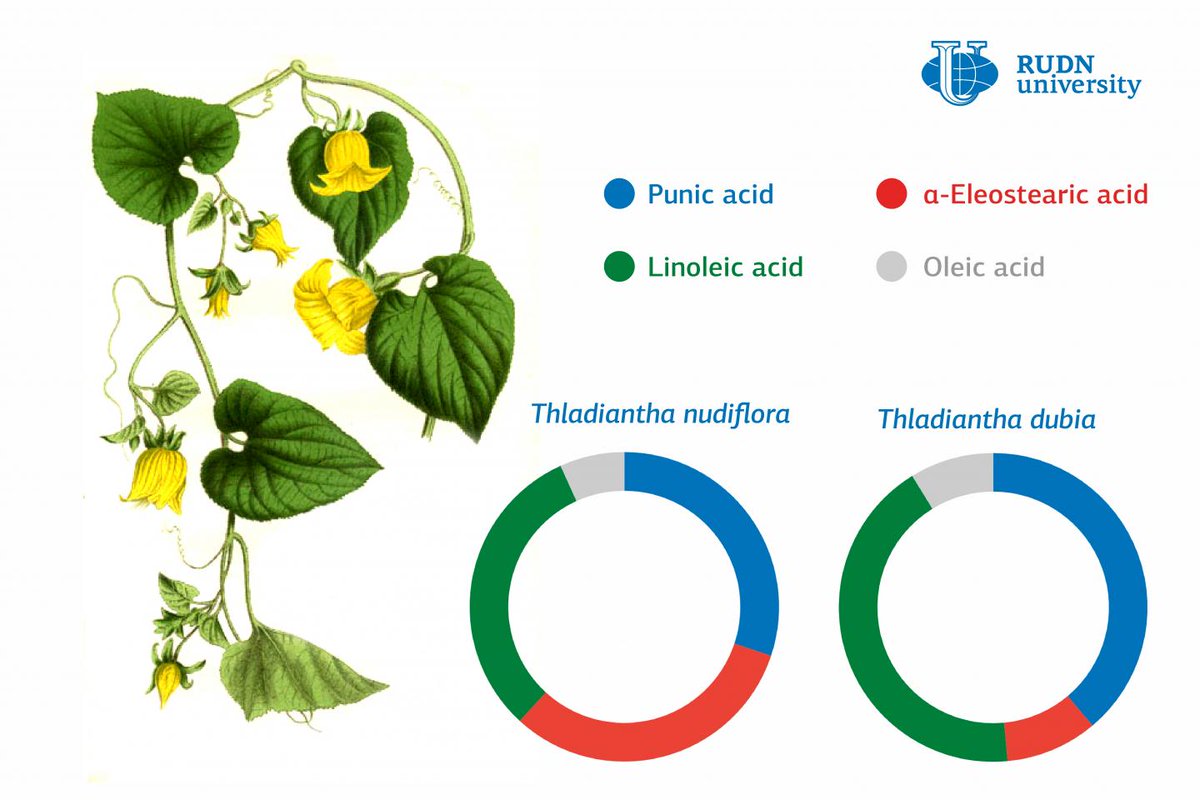RUDN University chemists studied the composition of oils extracted from popular medicinal plants

Plant oils consist of triglycerides (molecules that contain three acid residues), and the value of any type of oil for nutrition, medicine, and other applications is determined by the type of fatty acid residues its triglycerides contain. Unsaturated conjugated fatty acids with several dibonds between the atoms of carbon have anti-tumor properties and help combat obesity, inflammations, and diabetes. An international team of chemists from RUDN University was the first to identify the fatty acid residue content in the seeds of T. nudiflora and T. dubia, two plants from the genus of tubergourd (Thladiantha). Tubergourds are common in Southeast Asia and are often used as medicinal plants in traditional Chinese medicine. However, until recently the composition of their seed oils remained understudied.
“Triglycerides are the most important components of animal and plant oils. Knowing the quantitative and qualitative parameters of seed oil fats, one can understand the so-called fatty acid composition of the oil that shows whether it is beneficial for human health. This information can be used to identify counterfeit oils,” said Prof. Olga Kovalchukova, a PhD in Chemistry from the Department of General Chemistry at RUDN University.
The team used spectral and chromatographic methods to study the oils and a green technique to separate their components. A 1:3:17 mixture of fats, urea, and ethanol was kept in the freezer at —20? for 12 hours and then filtered. This way the team eliminated saturated fats from the oils.
Based on the study of the extract, the team concluded that valuable oils amounted to 37.1% and 40.3% of the seed weight of T. dubia and T. nudiflora, respectively. The chemists identified 15 types of triglycerides in such oils. Among all acid residues in them, four unsaturated acids prevailed: the volume of punicic acid amounted to 35.6% mole fractions in the T. dubia oil and 27% mole fractions in the T. nudiflora. oil; of linoleic acid—to 40% and 28%, respectively; of oleic acid—to 8% and 6%, respectively. The most interesting discovery was alpha-elaeosteraic acid with 28% content in the T. nudiflora oil. Its molecule contains three conjugated double bonds which make it toxic for some types of cancer.
“We were the first to analyze the quantitative and the qualitative content of fatty acids in tubergourd oils. We also confirmed that saturated and unsaturated fatty acids can be separated in the products of seed oil saponification by using urea crystals at —20C. This is a simple method that helps preserve all valuable unsaturated fatty acids,” added Prof. Olga Kovalchukova.
Article in Journal of Oleo Science.
Matilda Pavlovna Mityaeva was born in 1925. In November 1942, she volunteered for frontline duty. She participated in the Great Patriotic War from November 1942 to June 1945 as part of the 53rd Infantry Division of the 475th Infantry Regiment. She was wounded twice.
The team led by Sergey Zyryanov, Head of the Department of General and Clinical Pharmacology, became the winner of the All-Russian competition of scientific projects "Technologies for Human Health".
RUDN University constantly adapts to the changes of the modern world and responds to challenges flexibly. This allows us to keep the standard of a world-class research university. The sphere of science is no exception. Peter Dokukin, Head of the Research Division, presented the updated R&D Programme at the meeting of the RUDN University Academic Council.
Matilda Pavlovna Mityaeva was born in 1925. In November 1942, she volunteered for frontline duty. She participated in the Great Patriotic War from November 1942 to June 1945 as part of the 53rd Infantry Division of the 475th Infantry Regiment. She was wounded twice.
The team led by Sergey Zyryanov, Head of the Department of General and Clinical Pharmacology, became the winner of the All-Russian competition of scientific projects "Technologies for Human Health".
RUDN University constantly adapts to the changes of the modern world and responds to challenges flexibly. This allows us to keep the standard of a world-class research university. The sphere of science is no exception. Peter Dokukin, Head of the Research Division, presented the updated R&D Programme at the meeting of the RUDN University Academic Council.